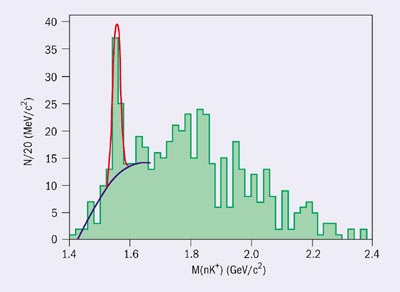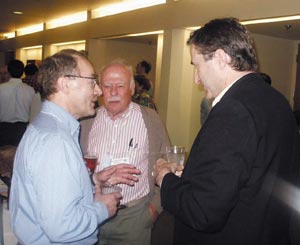Volker Burkert reports on Pentaquark 2003, the first topical workshop on exotic baryons, which was held at Jefferson Lab in November.
Pentaquarks – baryons made from five quarks – have been postulated and searched for in hadronic processes for decades. They are allowed by quantum chromodynamics (QCD), the theory of quarks and gluons, but until recently all searches for pentaquark states had been inconclusive. The breakthrough came in 1997 in a paper by three Russian physicists, Dmitri Diakonov, Victor Petrov and Maxim Polyakov. Within a chiral soliton model, they predicted an antidecuplet of 10 ground-state pentaquarks, three of which had exotic-flavour quantum numbers, meaning that their quantum numbers cannot be constructed from only three quarks. One of the states was predicted to be long-lived, and with a mass near 1530 MeV. It took another five years before a state close to this mass was reported from several experiments. This state, initially known as the Z+, is now called the Θ+(1540).
The discovery took the community by surprise. However, within only four months of the broad public announcement in July 2003, more than 60 theoretical papers appeared on the subject. It was therefore timely for the Department of Energy’s Thomas Jefferson Laboratory (JLab) to organize the first topical workshop on the subject. While around 30 to 35 physicists were originally expected to attend, almost 120 experimentalists and theorists from all over the world participated in the two-day workshop, which was organized into plenary and focus sessions. The latest results were presented by representatives from a number of experimental groups: GRAAL in France; COSY, ELSA and HERMES in Germany; SPring-8 in Japan; ITEP in Russia; JLab and RHIC in the US, and CERN.
Experimental evidence
Takashi Nakano from Osaka discussed the original finding of the Θ+ in the photoproduction of K+K– pairs off a plastic scintillation counter that happened to be installed in the beamline as a veto counter. He also presented very preliminary new data using a linearly polarized photon beam and a deuterium target. Representing the CLAS experiment, Valery Kubarovsky presented new experimental evidence for the Θ+ from JLab. The CLAS collaboration observed a signal with a significance of about 7.8 σ for the production on proton targets, the highest significance for this state to date (see figure 1). These data also show some evidence for production of the Θ+ through an intermediate excited nucleon, N*, with a mass near 2400 MeV. Such a state is also likely to be a pentaquark baryon, though with non-exotic quantum numbers. If this result is confirmed, it will be the first hint of a connection between the Θ+ and the spectroscopy of non-exotic baryon states.

New evidence has also come from the mining of old data. The re-analysis of neutrino bubble-chamber data presented by Mikhail Kubantsev of Fermilab shows a clear signal at the Θ+ mass in pKso, as does the HERMES experiment at DESY, which studied the same channel, as reported by Wolfgang Lorenzon. While this channel measures the absolute strangeness quantum number |S| = 1, it does not determine the sign. Although the exotic nature of the signal is not uniquely identified in this reaction, the absence of known Σ states that could mimic a pentaquark in this mass range is used to identify the state indirectly as the Θ+.
Michael Ostrick from Bonn presented data from the SAPHIR experiment at the ELSA machine, using photoproduction on protons. This included a re-analysis of the published results using a different technique to identify the Kso, which is used to tag the Θ+. He concluded that there is no obvious discrepancy between the published results and the re-analysed data. Carlo Schaerf of INFN Roma reported on searches for the Θ+ at the GRAAL detector at the European Synchrotron Radiation Facility using a photon beam on a deuterium target and a non-magnetic detector with a large BGO (bismuth gemanate) calorimeter. Although the reported statistics are currently too low to conclude much, the search in the exclusive channel with a ΛΘ+ in the final state looks promising.
Other searches are also underway at the COSY synchrotron at the Jülich Research Centre using proton-proton scattering, where the Θ+ may be produced in association with a Σ+ hyperon, and with the STAR and PHENIX detectors at Brookhaven’s Relativistic Heavy Ion Collider (RHIC). For central gold-gold collisions at the RHIC, one expects about one Θ+ per collision accompanied by thousands of other particles.
Cascade particles
The Θ+ is not the only pentaquark state that the models predict. In the chiral soliton model the Θ+ is an isosinglet member of an antidecuplet of 10 states that, in a quark picture, are made of four quarks and one antiquark. The model predicts nine other pentaquark states, two of which have exotic-flavour quantum numbers. These are the cascade particles, Ξ— and Ξ+. Indeed the Ξ— may have been observed at CERN in the NA49 experiment. Representing NA49, Kreso Kadija reported evidence for a narrow cascade Ξ— at a mass of 1862 MeV and with a width of less that 18 MeV (figure 2). Such a state must have exotic-flavour quantum numbers requiring at least five quarks. These data lend support to the symmetry properties of pentaquark states as predicted in the chiral soliton model, or in the quark-cluster picture.

Representatives of all theoretical persuasions were present at the workshop. Dmitri Diakonov of NORDITA in Copenhagen presented reasons why the Θ+ might be so light. In the chiral soliton model, it is a collective excitation of the mean chiral field that binds the baryons, and not a sum of the constituent quarks. For the same reasons it would be narrow. In the infinite momentum frame it can only decay in transitions between the Θ+ and the five-quark component of the nucleon wave function. Simon Capstick of Florida State presented an overview of various theoretical models for pentaquarks. A natural explanation for the narrowness of the Θ+ is that it is an isotensor baryon. However, this possibility is currently not supported by the experimental data.
Alternative models
Robert Jaffe of MIT presented the quark cluster model that starts from two diquark clusters and one strange antiquark. This model also predicts an antidecuplet but with mass assignments that differ from the one predicted by the chiral soliton models. One unresolved problem is that this model needs a narrow nucleon-like five-quark state, which is identified with the Roper resonance at 1440 MeV. However, this state has a width of more than 300 MeV. Marek Karliner of Cambridge University discussed an alternative quark cluster model, developed with Harry Lipkin of the Weizmann Institute, where the five-quark states are composed of triquark-diquark clusters. They predict that narrow five-quark states analogous to the Θ+ should also occur in the charm and bottom sector.

Michal Praszalowicz of Brookhaven discussed pentaquarks in the SU(3) Skyrme and chiral quark soliton models. The first lattice QCD results presented by Kei-Fei Liu of Kentucky University and Tamas Kovacs of Wuppertal do not present a consistent picture. Two groups (Kovacs and Shoichi Sasaki) measured a pentaquark signal consistent in mass with the experimental observation, while a third group (Liu) saw no resonant signal. The groups with a positive result predict the parity of the Θ+(1540) to be negative, while both the chiral soliton and quark cluster models require positive parity.
Discussions in the focus sessions addressed questions of how to obtain more information on properties such as spin/parity and the natural widths of the Θ+(1540), as well as new experiments that can identify other predicted pentaquark states. Expected new data from JLab should have sufficient statistics to measure full angular distributions and determine the spin. Identification of the parity, meanwhile, may require measurements using linearly polarized photon beams or experiments with hadron beams.
The mass of the Θ+(1540) is not as well established as one might expect from a narrow state, and ranges from 1528 to 1555 MeV, which is outside the uncertainties given by the experiments. It was emphasized that this issue should be addressed urgently as it has impact on mass predictions for other five-quark states.

The question: “why have pentaquark states not been seen before?” was asked frequently and some answers were given. For example, data on K+n phase shifts are quite poor in the corresponding mass range and have obvious holes. At the end of the workshop one piece of early evidence was shown from data on K+p scattering from the 2 m bubble chamber at CERN. The data show a small but significant peak at a pK0 mass of 1540 MeV, however only at the highest K+ beam momentum.
In the final session Kim Maltman of York University, Toronto, put the experimental evidence and theoretical approaches into their proper perspectives and discussed the relative merits of the different theoretical concepts. A second workshop on pentaquarks is planned for July 2004, and will be held at SPring-8 in Japan. A Program Advisory Meeting held at JLab from 12-16 January 2004 also accepted four additional pentaquark experiments, which will continue to add to the collective knowledge about this baryon system.
•For the full programme, including all the talks, see: www.jlab.org/intralab/calendar/archive03/pentaquark/program.html.








